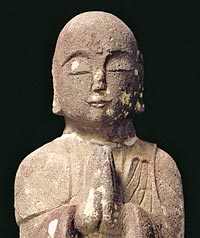Hinduism and Buddhism were primarily transmitted from South
India to Southeast Asia. During the Khmer dynasty, belief in the Hindu
gods, ancestors, and buddhas coexisted harmoniously. When Theravada
Buddhism, the early form of this belief, later became mainstream, their
buddhas, who indiscriminately loved all beings, began to express gentle
smiles.
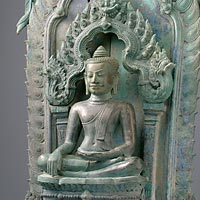
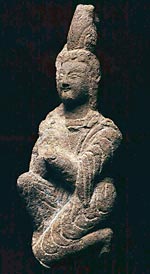
The collapse of the Han dynasty and the rise of the nomadic
empire that transformed the East Asian world led to flourishing
cultural exchange, especially of Buddhism, via the Silk Road.
This also meant the appearance of smiles on images of buddhas,
bodhisattvas, and devotees.
The people who held power in ancient Japan built large mound tombs and
placed haniwa on top of them. Haniwa originally represented barriers to
sacred spaces and ritual vessels, though later they took the form of
humans and animals that signified funerary rites. Their simple smile
expresses the noble visage of the ancients.
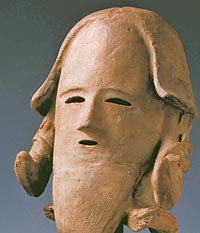
In the Hakuhō and late Heian period of Japan, buddha images with
child-like forms were favored. A feminine sensibility, which was a
common quality of Buddhism at the time, may have contributed to the
production of this natural, unaffected expression.
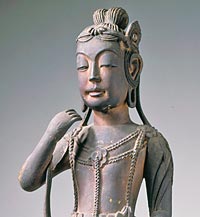
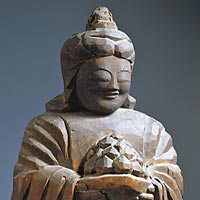
In Tang China, it was believed that the gods took refuge in the Buddhist teachings and took the form of priests. In Japan, in addition to priestly forms, the gods appeared as salvific beings such as buddhas and bodhisattvas. Also, the fusion of Buddhism and ancient mountain beliefs created the ascetic practice of shugendō. The priest Enkū, who was influenced by these ideas, vowed to carve 120,000 buddhas and made a pilgrimage throughout Japan. The rustic smiles of Enkū’s buddhas gracefully express nature’s bounty.
Jizō (Skt., Ksitigarbha) images were erected at the entrance to cemeteries and places for the repose of souls in early Japan in hopes that the deceased would be saved in the next world. This concept also gave rise to the meaning of spiritual barriers as they fused with belief in folk deities that administer the borders between this world and hell and led to erection of guardian deities for travelers on roadsides. These guardians as well as Jizō, who protected those who traversed their paths, truly have a smile nurtured by nature.
